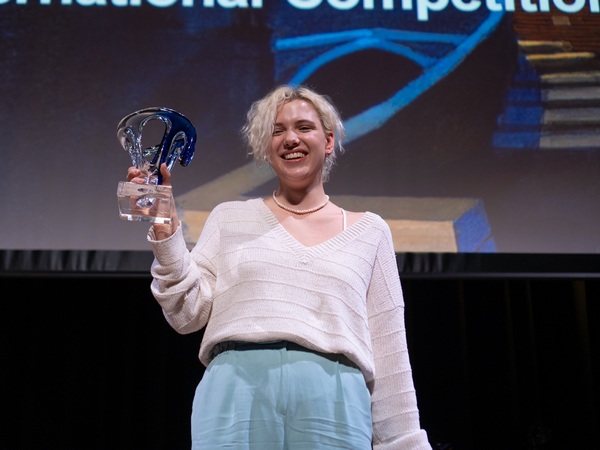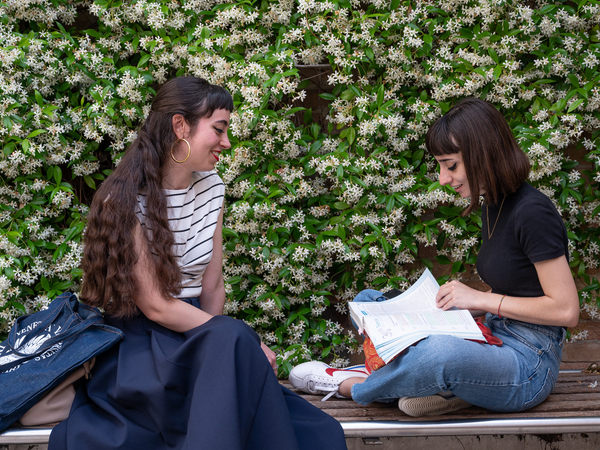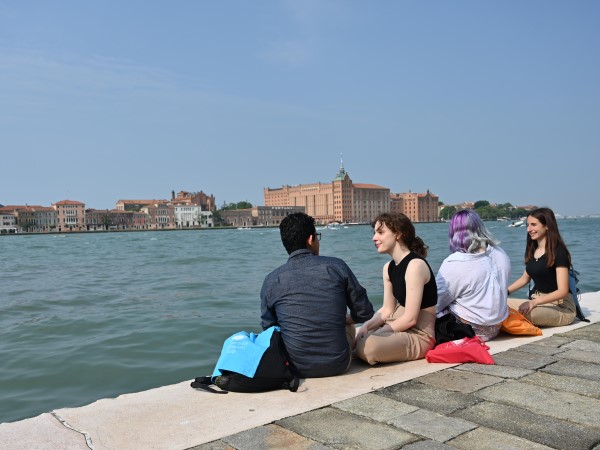If you think cookbooks are B-list, you've never held a copy from Phaidon Press. The most refined publishing house in the world, famous for the visual arts, has been opening its doors to Food for over 10 years thanks to the intuition of an Italian woman and its success has been 'stellar'. She is from Como, cosmopolitan and graduated with a degree in Art History from Ca’ Foscari in the late 1980s. In 2014 the Wall Street Journal crowned Emilia Terragni the 'queen of cookbooks' and she recently appeared among the 50 women of food in the Corriere della Sera's ranking. As editorial director, she has published the best chefs in the world such as Adrià, Bottura and Redzepi. And it all started with the English translation of ‘Il Cucchiaio d'Argento’ (The Silver Spoon).
A degree in Art History (from Ca 'Foscari), cosmopolitan and passionate about travel. These - and certainly many others - appear to be key ingredients in your career. Can you tell us about your journey from Como to London, passing through Venice?
For me it has always been very important to travel and live in different places. In this sense Venice was a big step. I lived there for almost ten years, starting from my university days. Living alone, meeting new friends, appreciating the new and the different was an interesting experience. I specialised as a curator of contemporary art in Siena and then in Prato, always based in Venice. I then moved to Germany, to Kassel, to work on Documenta, one of the most important international contemporary art events in Europe. The highly international dimension of that scenario made me realise that I wanted to work internationally, with all the challenges - including linguistic - that this involved. From there I continued to apply myself and worked hard. I worked at the Milan Triennale, at the Iuav and Biennale in Venice, in Germany and Switzerland, at the Barragàn Archive and at the Vitra Design Museum in Basel. This too was a fundamental step, which brought me back to my great passion, design. In Switzerland it was 5 years of hard work, but I learned 4 languages, organised an exhibition and published a book. In Basel I met the owners of Phaidon, one of the leading publishers of visual arts, architecture, photography and design. They invited me to London to work as a design editor. For the first time I saw books from the other side. Publishing is a real art that I had to learn, and this is where the adventure with cookbooks started. Started on a whim, it 'blew up' in our hands and it works great.
For Phaidon, you published the English edition of what is considered the quintessential Italian cooking manual, 'The Silver Spoon'. Can you tell us about the inspiration behind this and the development of your editorial line?
It was purely an accident. In Italy 'The Silver Spoon' is published by Domus. In 2004 we learned that Domus was signing an agreement with our competitors. We went to Milan to stop the agreement, but it was already signed. The editors were still interested in collaborating with Phaidon and, almost as a joke, they proposed 'the Silver Spoon'. I was immediately thrilled. We were talking about the 'bible' of Italian cuisine, a book that I had always seen at home and that I knew well… we jumped on the opportunity! Editing a cookbook turned out to be much more complicated than we expected. Cooking represents culture. In Anglo-Saxon culture the ingredients are listed as they appear in the recipe, in Italian culture they are listed in order of importance. In Italy it is assumed that some cooking steps can be left out from the recipe as they are well known, while in the rest of the world they can not. We had to rewrite everything, working on an incredible amount of text. It was a springboard but also a training ground. The success was incredible, we reprinted it one month later. It was a surprise for us too and so we continued.
From art historian to 'queen of cookbooks'. Is there a link between art, food and publishing in your career?
Yes, this was precisely my path, and it was the success of our editorial line. We deal with cookbooks just like we would art and design books. In these areas, the quality of the book - the choice of photos, graphics, paper, for example - is as important as the content. At the time, however, there was a tendency to make less curated cookbooks. Even when choosing the content and chefs to publish, we act as architects and designers. The quality of the work is important, but the key word is innovation.
Projects like 'A day at El Bulli' and 'Where chefs eat' let us experience places we would probably never set foot: the most exclusive kitchens and restaurants chosen by the best chefs in the world. How did these ideas come about?
'A day at El Bulli' was another gamble that came about in 2007, when the world of chefs began to take on importance and became mainstream. We googled who the best chefs in the world were. I didn't even know who number one, Ferran Adrià, was, but we called him on the phone. He was amused, he understood that we weren't in the trade and that we were moving into new territory. He agreed to meet us and we flew to Barcelona, to his workshop. We asked him two questions: Would he run a restaurant in Japan? Did he want to publish a book with us? He responded that he never cooked outside his kitchen and that he made his own books.
Months later, in September, he invited us to have dinner in El Bulli, on the Costa Brava. With just 15 tables and 50 seats, getting a table at El Bulli was like winning the lottery. We accepted straight away. He wanted to meet us in the afternoon to tell us that he had changed his mind, he would publish a book with us. Thus 'A day at El Bulli’ was born. Our relationship with him has also lasted for many years. We like to form relationships with our authors. Conversations with them are important.
'Where chefs eat' was born because at the time I travelled a lot with the chefs we collaborate with, and it's a lot of fun but it's a nightmare when it comes to food: they either eat well or they don't eat. So I started contacting the local chefs for recommendations. I started making lists for friends and so began the project. A simple idea but very curated in terms of the execution and the networking work behind it. Of course we had to inspire the chefs with special requests, for example 'Which restaurant is worth eating at' or 'which one would you have liked to open'. Their community is very close and supportive. Once the recommendations were received, all our field research work began, essential for the success of the book. A series was born, which we replicated with architects' favourite hotels.
Will you 'virtually’ let us into your office? What is your work process? What characteristics do you look for in your collaborators and what does Phaidon ask of young people interested in the publishing world?
I work closely with my team, split between London and New York, and with the other publisher who deals with art and fashion. I have a direct team of 8 editors, whom I continually consult and discuss ideas and projects with. We recently moved to an open space in the London office. Due to the way we work, the isolation caused by Covid-19 has been tough. I generally dedicate the morning to meetings and mailing and use the afternoon to read and develop ideas.
In my work, the main strength for me is lateral thinking, which makes you open to finding something you weren’t looking for. This is what happened to me for example with cooking. I recommend and ask my collaborators to believe that anything is possible. Many of our books were born from impossibility. Of course, you also need to be able to tell if and when things don't work out. I especially appreciate the ability to team up, to share and to build relationships. To young people, in particular, I say: dare to aim high. You have to be brave, get involved, be willing to get out of your comfort zone. I worked with students from the Pollenzo school of gastronomy, who I asked to design books in groups. The coolest and craziest ideas came from the groups that started out with the broadest visions.
Print and web publishing. From your point of view are they at odds or are there two parallel paths to follow? If they exist, how are they different?
I wouldn't say there is competition. Roles need to be redefined. The book is still the best way to disseminate some information. The pdf format doesn’t have the same quality and is often not the best way to share digital content. In our books we do very precise editing, important both on an aesthetic level and for the pleasure of reading. The choice of font, the arrangement of the text… the typography is a complex art with a world and many studies behind it. In the digital world, all of this changes entirely. The web, however, can be very effective in offering a complete overview of the work of an architect, for example. Perhaps it is also the most versatile tool for a catalogue, even if it does not guarantee the sequence and arrangement of the images. To get the best out of both tools, you need to focus on their characteristics, and one above all: a book is static, the web is not.
Which failure do you still remember and what is your greatest professional success?
I'm not good at writing. I started writing about contemporary art, but to write well you need experience but also talent. It still pains me, but I write very little. I have chosen a career that is more organisational than authorial, and when I do write I always have my texts reviewed. I believe success is being able to bring together people and ideas on any front and being able to capture the best.
This summer a controversy broke out in Italy over the words of the Deputy Minister of Economy and Finance, Laura Castelli, on Tg2. It seemed to the public that she was inviting restaurateurs to change jobs. She did not say this exactly, but she noted how Covid has changed our habits, putting today’s restaurant world in difficulty. In your opinion, how should the business model that has worked to date change?
It is not just a problem faced by the restaurant industry, which in any case was hard hit and paid a high price. The proliferation of businesses lacking quality shows an industry based on rules that no longer work. Quality will only bring excellence to certain types of offerings, and in the restaurant industry I mean not just the quality of the food but quality customer relations and love for one's work. Those with these characteristics are reopening, and they have the support of the community.
Venice is an example of this. It did not take a pandemic to understand how attention, care and art are all too often lacking in the city's commercial activities. Yet it is also a city full of wonderful places where you can eat well. The high pressure of tourism risks making everything the same and also damaging those who do a good job. I hope that quality will shine through.
I’ll end with two curiosities: at your ideal dinner what is on your plate and who is the dinner guest?
I love home-made things, made with a passion for cooking and for the love of making guests feel good. Ideal guests? Friends, like the ones who’ll be at the dinner party I'm preparing for tonight.











